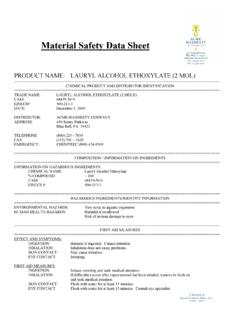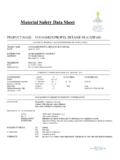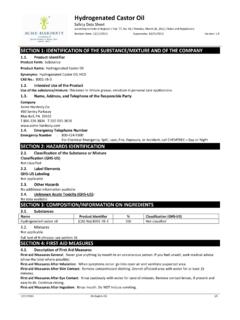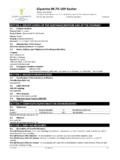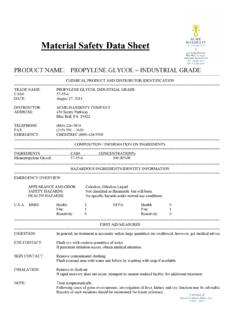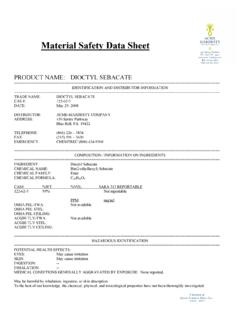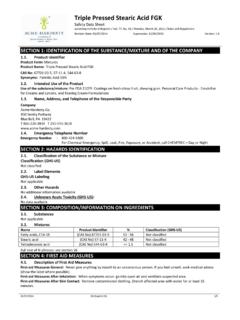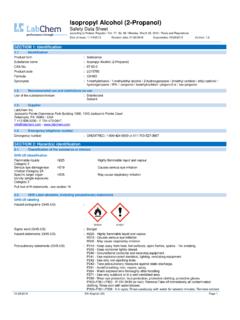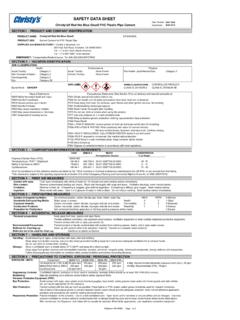Transcription of Cocoamidopropyl Betaine SDS US 033016 FINAL (2)
1 Cocoamidopropyl Betaine Safety Data Sheet According to Federal Register / Vol. 77, No. 58 / Monday, March 26, 2012 / Rules and Regulations Date of Issue: 03/30/2016 Version: EN (English US) 1/7 SECTION 1: IDENTIFICATION OF THE SUBSTANCE/MIXTURE AND OF THE COMPANY Product Identifier Product Form: Mixture Product Name: Cocoamidopropyl Betaine CAS No: 61789-40-0 Synonyms: CAPB Intended Use of the Product Use of the substance/mixture: Personal Care products Name, Address, and Telephone of the Responsible Party Company Acme-Hardesty Co 450 Sentry Parkway Blue Bell, PA 19422 T 866-226-3834 T 215-591-3610 Emergency Telephone Number Emergency Number : 800-424-9300 For Chemical Emergency, Spill, Leak, Fire, Exposure, or Accident, call CHEMTREC Day or Night SECTION 2.
2 HAZARDS IDENTIFICATION Classification of the Substance or Mixture GHS-US classification Skin Irrit. 2 H315 Eye Irrit. 2A H319 Aquatic Acute 1 H400 Full text of hazard classes and H-statements : see section 16 Label Elements GHS-US Labeling Hazard Pictograms (GHS-US) : GHS07 GHS09 Signal Word (GHS-US) : Warning Hazard Statements (GHS-US) : H315 - Causes skin irritation H319 - Causes serious eye irritation H400 - Very toxic to aquatic life Precautionary Statements (GHS-US) : P264 - Wash exposed areas. thoroughly after handling. P273 - Avoid release to the environment. P280 - Wear protective gloves, protective clothing, and eye protection. P302+P352 - If on skin: Wash with plenty of water. P305+P351+P338 - If in eyes: Rinse cautiously with water for several minutes. Remove contact lenses, if present and easy to do.
3 Continue rinsing. P321 - Specific treatment (see section 4 on this SDS). P332+P313 - If skin irritation occurs: Get medical advice/attention. P337+P313 - If eye irritation persists: Get medical advice/attention. P362+P364 - Take off contaminated clothing and wash it before reuse. P391 - Collect spillage. P501 - Dispose of contents/container in accordance with local, regional, national, and international regulations. Cocoamidopropyl Betaine Safety Data Sheet According to Federal Register / Vol. 77, No. 58 / Monday, March 26, 2012 / Rules and Regulations EN (English US) 2/7 Other Hazards Other Hazards Not Contributing to the Classification: Exposure may aggravate pre-existing eye, skin, or respiratory conditions. Unknown Acute Toxicity (GHS-US) No data available SECTION 3: COMPOSITION/INFORMATION ON INGREDIENTS Substance Not applicable Mixture Name Product Identifier % GHS-US classification Water (CAS No) 7732-18-5 69 - 71 Not classified 1-Propanaminium, 3-amino-N-(carboxymethyl)-N,N-dimethyl-, N-coco acyl derivatives, hydroxides, inner salts (CAS No) 61789-40-0 29 - 31 Skin Irrit.
4 2, H315 Eye Irrit. 2A, H319 Aquatic Acute 1, H400 Full text of H-phrases: see section 16 SECTION 4: FIRST AID MEASURES Description of First Aid Measures First-aid Measures General: Never give anything by mouth to an unconscious person. If you feel unwell, seek medical advice (show the label where possible). First-aid Measures After Inhalation: When symptoms occur: go into open air and ventilate suspected area. Obtain medical attention if breathing difficulty persists. First-aid Measures After Skin Contact: Remove contaminated clothing. Drench affected area with water for at least 15 minutes. Obtain medical attention if irritation develops or persists. First-aid Measures After Eye Contact: Rinse cautiously with water for at least 15 minutes. Remove contact lenses, if present and easy to do.
5 Continue rinsing. Obtain medical attention. First-aid Measures After Ingestion: Rinse mouth. Do NOT induce vomiting. Obtain medical attention. Most Important Symptoms and Effects, Both Acute and Delayed Symptoms/Injuries: Causes serious eye irritation. Causes skin irritation. Symptoms/Injuries After Inhalation: Not expected to present a significant inhalation hazard under anticipated conditions of normal use. Prolonged exposure may cause irritation. Symptoms/Injuries After Skin Contact: Redness, pain, swelling, itching, burning, dryness, and dermatitis. Symptoms/Injuries After Eye Contact: Contact causes severe irritation with redness and swelling of the conjunctiva. Symptoms/Injuries After Ingestion: If a large quantity has been ingested: May cause nausea, vomiting, and diarrhea. Ingestion may cause adverse effects.
6 Indication of Any Immediate Medical Attention and Special Treatment Needed If medical advice is needed, have product container or label at hand. If exposed or concerned, get medical advice and attention. SECTION 5: FIREFIGHTING MEASURES Extinguishing Media Suitable Extinguishing Media: Alcohol foam, dry chemical, carbon dioxide, water spray, fog. Use extinguishing media appropriate for surrounding fire. Unsuitable Extinguishing Media: Do not use a heavy water stream. Use of heavy stream of water may spread fire. Special Hazards Arising From the Substance or Mixture Fire Hazard: Not considered flammable but may burn at high temperatures. Explosion Hazard: Product is not explosive. Reactivity: Stable at ambient temperature and under normal conditions of use. Hazardous reactions will not occur under normal conditions.
7 Advice for Firefighters Precautionary Measures Fire: Exercise caution when fighting any chemical fire. Firefighting Instructions: Exercise caution when fighting any chemical fire. Use water spray or fog for cooling exposed containers. Protection During Firefighting: Do not enter fire area without proper protective equipment, including respiratory protection. Other Information: Do not allow run-off from fire fighting to enter drains or water courses. Cocoamidopropyl Betaine Safety Data Sheet According to Federal Register / Vol. 77, No. 58 / Monday, March 26, 2012 / Rules and Regulations EN (English US) 3/7 SECTION 6: ACCIDENTAL RELEASE MEASURES Personal Precautions, Protective Equipment and Emergency Procedures General Measures: Avoid breathing (vapor, mist, spray). Avoid all contact with skin, eyes, or clothing.
8 For Non-emergency Personnel Protective Equipment: Use appropriate personal protection equipment (PPE). Emergency Procedures: Evacuate unnecessary personnel. For Emergency Responders Protective Equipment: Equip cleanup crew with proper protection. Emergency Procedures: Ventilate area. Upon arrival at the scene, a first responder is expected to recognize the presence of dangerous goods, protect oneself and the public, secure the area, and call for the assistance of trained personnel as soon as conditions permit. Environmental Precautions Prevent entry to sewers and public waters. Avoid release to the environment. Collect spillage. Methods and Material for Containment and Cleaning Up For Containment: Absorb and/or contain spill with inert material, then place in suitable container.
9 Contain any spills with dikes or absorbents to prevent migration and entry into sewers or streams. Methods for Cleaning Up: Clean up spills immediately and dispose of waste safely. Transfer spilled material to a suitable container for disposal. Contact competent authorities after a spill. Reference to Other Sections See heading 8, Exposure Controls and Personal Protection. See Section 13, Disposal Considerations. SECTION 7: HANDLING AND STORAGE Precautions for Safe Handling Precautions for Safe Handling: Wash hands and other exposed areas with mild soap and water before eating, drinking or smoking and when leaving work. Avoid breathing vapors, mist, spray. Avoid contact with skin, eyes and clothing. Hygiene Measures: Do not eat, drink or smoke when using this product. Handle in accordance with good industrial hygiene and safety procedures.
10 Conditions for Safe Storage, Including Any Incompatibilities Technical Measures: Comply with applicable regulations. Storage Conditions: Keep container closed when not in use. Store in a dry, cool place. Keep/Store away from direct sunlight, extremely high or low temperatures and incompatible materials. Incompatible Products: Strong acids, strong bases, strong oxidizers. Incompatible Materials: Sources of ignition. Direct sunlight. Specific End Use(s) Personal Care products SECTION 8: EXPOSURE CONTROLS/PERSONAL PROTECTION Control Parameters For substances listed in section 3 that are not listed here, there are no established exposure limits from the manufacturer, supplier, importer, or the appropriate advisory agency including: ACGIH (TLV), AIHA (WEEL), NIOSH (REL), or OSHA (PEL).
